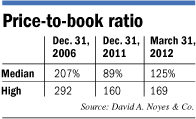Subscriber Benefit
As a subscriber you can listen to articles at work, in the car, or while you work out. Subscribe Now
 A resumption of Indiana bank consolidation may be at hand, as key ingredients are falling into place: rising stock prices for buyers, more realistic price expectations by sellers, and a gradual restoration of health and confidence within the beleaguered sector.
A resumption of Indiana bank consolidation may be at hand, as key ingredients are falling into place: rising stock prices for buyers, more realistic price expectations by sellers, and a gradual restoration of health and confidence within the beleaguered sector.
The U.S. banking industry has been consolidating for several decades, and that needs to continue. Most Western countries have from a few to a few dozen. The United States has about 7,000. There is a need for community banks, but many are too small to function effectively in an increasingly complex and regulated world.
Nearly 400 independent banking organizations were based in Indiana when it changed its banking laws in 1985; now, there are fewer than 150.
The financial crisis, which led us into the Great Recession was hard on banks.
With some exceptions, banks were hurt badly. Most suffered for several years, grappling with bad loans, reduced capital, increased regulatory interference, tumbling stock prices, assaults on their image and character, and shaken confidence.
The economy has begun to recover, albeit modestly, and markets have improved. Large-cap stocks have made a near complete recovery. Technology stocks have come back nicely, though remaining well below levels seen before the tech bubble burst in the early 2000s. But bank stocks remain far below highs achieved before the crash. Large bank stocks, as represented by the NASDAQ Bank Index, are scarcely above half their pre-crash highs.
Little healthy bank merger and acquisition activity has taken place since the crash, because bankers and regulators were struggling to keep banks afloat, because investors trashed bank stock prices, leaving prospective buyers with a devalued currency with which to do deals, and because what might be for sale was potentially, or in fact, toxic.
With Indiana bank stock valuations plummeting, and challenges soaring, merger-and-acquisition activity came to a near halt. The supply of healthy, attractive potential sellers was down, potential buyers were saddled with their own problems, and practically no banks had a currency (stock) that anyone wanted. Indiana bank M&A dropped from 61 announced in 1986, the year after Indiana changed its banking laws, to just a handful in the past few years.
Many banks still suffer the lingering problems of long workouts of problem assets, but most see sunnier days ahead.
The measure of bank stock prices most relevant to a prospective buyer’s ability to do acquisitions is its multiple of price-to-tangible-book value, or price-to-book ratio. That is because most buyers either pay sellers with stock, or if they use cash, most eventually will need to sell stock to replenish capital.
 So, if a buyer’s stock is valued more dearly (by a higher price-to-book ratio), he can afford to pay a higher price. Indiana’s Listed Bank Group is a group of the larger banks whose stock is publicly traded, and which typically are the more active buyers. The following table shows the median and high levels of this key pricing determinant for the LBG at the end of 2006, before the crash, at the end of 2011, and on March 31, 2012:
So, if a buyer’s stock is valued more dearly (by a higher price-to-book ratio), he can afford to pay a higher price. Indiana’s Listed Bank Group is a group of the larger banks whose stock is publicly traded, and which typically are the more active buyers. The following table shows the median and high levels of this key pricing determinant for the LBG at the end of 2006, before the crash, at the end of 2011, and on March 31, 2012:
As these figures illustrate, price-to-book multiples remain well below pre-crash levels, but they have shown significant improvement recently. More important, a few Indiana banks enjoy prices in excess of 150 percent of book.
While bank stock prices are improving, price expectations of sellers have moderated. Deals were being done at twice book and higher before the crash, when buyers’ multiples were over twice book. Lately, it looks like sellers are receptive to lower multiples.
Two Indiana bank M&A deals have been announced this year. In each case, the buyer’s stock was trading around 150 percent of book; in both cases, the stated value of the transaction was about 150 percent of book. That makes easy math.
Are more bank deals in the works? The ingredients are falling into place.•
__________
Reed is an investment banker, bank analyst and consultant, and president of David A. Noyes & Co.’s Investment Banking Group. Views expressed here are the writer’s.
Please enable JavaScript to view this content.
